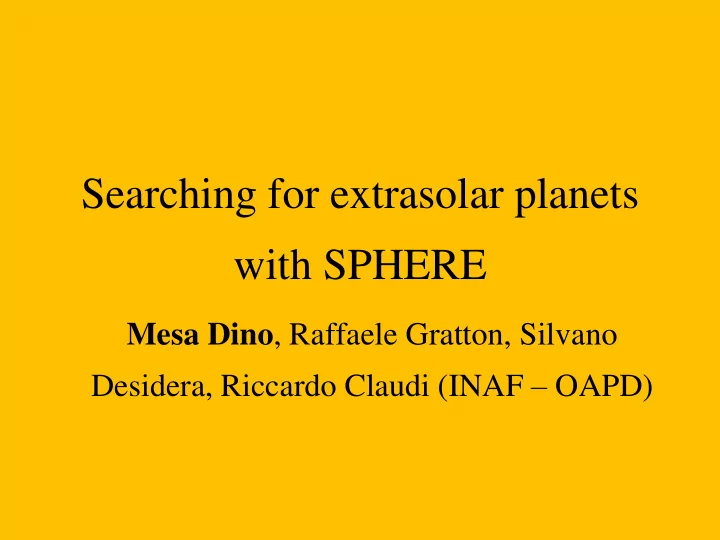

Searching for extrasolar planets with SPHERE Mesa Dino , Raffaele Gratton, Silvano Desidera, Riccardo Claudi (INAF – OAPD)
The field of extrasolar planets today • At the moment 2017 planets have been discovered. Of these, 666 have been discovered by Radial Velocity, 1300 by transiting, 46 by microlensing and just 65 by direct imaging. • Direct imaging is a very challenging method because of the large contrast (~10 -6 for a young Jupiter-like planets and down to 10 -8 -10 -9 for an old Jupiter-like planets arriving to 10 -10 for an Earth-like planets) and of small angular sepation (of the order of few tenths of arcsec for a planet at a a distance up to 100 pc and a separation of 10 AU) from the hist star. • Direct imaging is however important because it can give us the possibility to determine the planetary orbit, to obtain spectro-photometric data from the planet (so information about its composition), to obtain information about interaction between planets and disks and then about the evolution of planetary systems. Moreover, coupling direct imaging with indirect technique could allow a precise characterization of the planets.
Tools needed for successful direct imaging of extrasolar planets To be able to image an extrasolar planets we need the following tools: 1. High efficiency coronagraphy to strongly attenuate the light from the host star. 2. Extreme Adaptive Optics (XAO) systems able to provide high Strehel ratio (~90%) 3. Effective methods for the reduction of the speckle noise that can mimick the presence of a planet. The main methods are: • Angular Differential Imaging (ADI) that exploits the rotation of the FOV diring the observing time • Spectral deconvolution (SD) that exploits the scaling of the speckle pattern with different wavelengths. • Spectral Differential imaging (SDI) that exploits different structures in the sepctrum of the star and in the spectrum of the planets (e.g. absorbing bands of the methane in the T-type spectra) Various algorithms has been implemented to fully exploit these techniques (e.g. PCA or T-LOCI)
High contrast imaging pillars High-order AO: Coronagraphy: Differential imaging: Contrast ~10 3 Contrast ~10 4 Contrast ~10 6
What is SPHERE SPHERE is a VLT isntrument aimed to the direct imaging of extrasolar planets. It is composed by three scientific modules : • IFS a low resolution (R=30-50) integral field spectrograph) operating between 0.95 and 1.65 μ m. FOV=1.7x1.7 arcsec • IRDIS an infrared (0.95-2.32 μ m) imager mainly aimed to use the SDI. FOV=11x11 arcsec. • ZIMPOL is a direct and differential polarimetric imager operating in the visible (0.5-0.9 μ m). FOV=3.5x3.5 arcsec. In its common path, it has a set of different high performance coronagraph (both Lyot and 4 quadrant) adapted for different observing bands and the extreme AO system called SAXO (Sphere AO for eXoplanets Observations)
SAXO • The turbulence perturbation is measured through a spatially filtered 40x40 lenslets Shack- Hartmann sensor equipped with red-sensitive, sub-electron noise CCD at 1.2 kHz of frequency. • The correction is performed by a 41x41 actuators Deformable Mirror • Also, it servo controls the pupil position, and the fine on-coronagraph centering in NIR thanks to a dedicated NIR sensor (DTTS). • It also compensates for static non-common path aberrations to maximize the image quality at the level of the coronagraphic focal planes performing off-line measurements and on- line compensation using a phase diversity algorithm
SAXO scheme
SAXO performance
Results with SPHERE: contrast IFS 5 σ contrast at 0.3 arcsec ~10 -6 for Tau Ceti (R=2.88)
Results with SPHERE: images HR4796 Zurlo et al. 2016 Milli et al. 2015 HR8799 with IRDIS HD135344B (Stolker et al 2016 HR8799 with IFS Maire et al. 2016 Pz Tel HD1160
Not only nice images … Spectral retrieving and classification (with IFS) Zurlo et al. 2016 And moreover: precise astrometry orbit determination photometry companion characterization (mass, T eff )
Problems with AO: LWE
Conclusion SPHERE (and in particular its adaptive optics) is working well apart for some problems (dead actuators, LWE). The performance are as specified: contrast better than 10 -6 for bright targets. Even in very bad conditions (seeing above 2 arcsec) a contrast better than 10 -4 can be retrieved. AO performance: SR of the order of 90% is normal during operation.
Recommend
More recommend